UON EPID6600 Assignment 2: Public Health Study Analysis Report
VerifiedAdded on 2022/09/30
|6
|1320
|41
Homework Assignment
AI Summary
This assignment solution addresses several key areas within public health and epidemiology. It begins with recommendations for surgeons regarding a study on tonsillectomy and mortality, emphasizing data collection and research question formulation. The solution then explores various sampling methods, including simple random, systematic, and stratified sampling, with justifications for each based on specific scenarios. A detailed analysis of a cohort study examining alcohol consumption and mortality is presented, including calculations of risk and relative risk, along with a discussion of potential biases and suggestions for a more comprehensive study. Finally, the assignment analyzes a study on smoking, lung cancer, and ischaemic heart disease, identifying the study type, advantages, and potential issues, calculating risk ratios and attributable risk, and discussing the rationale behind the study's design choices. This comprehensive analysis provides insights into study design, data analysis, and interpretation in the field of public health.
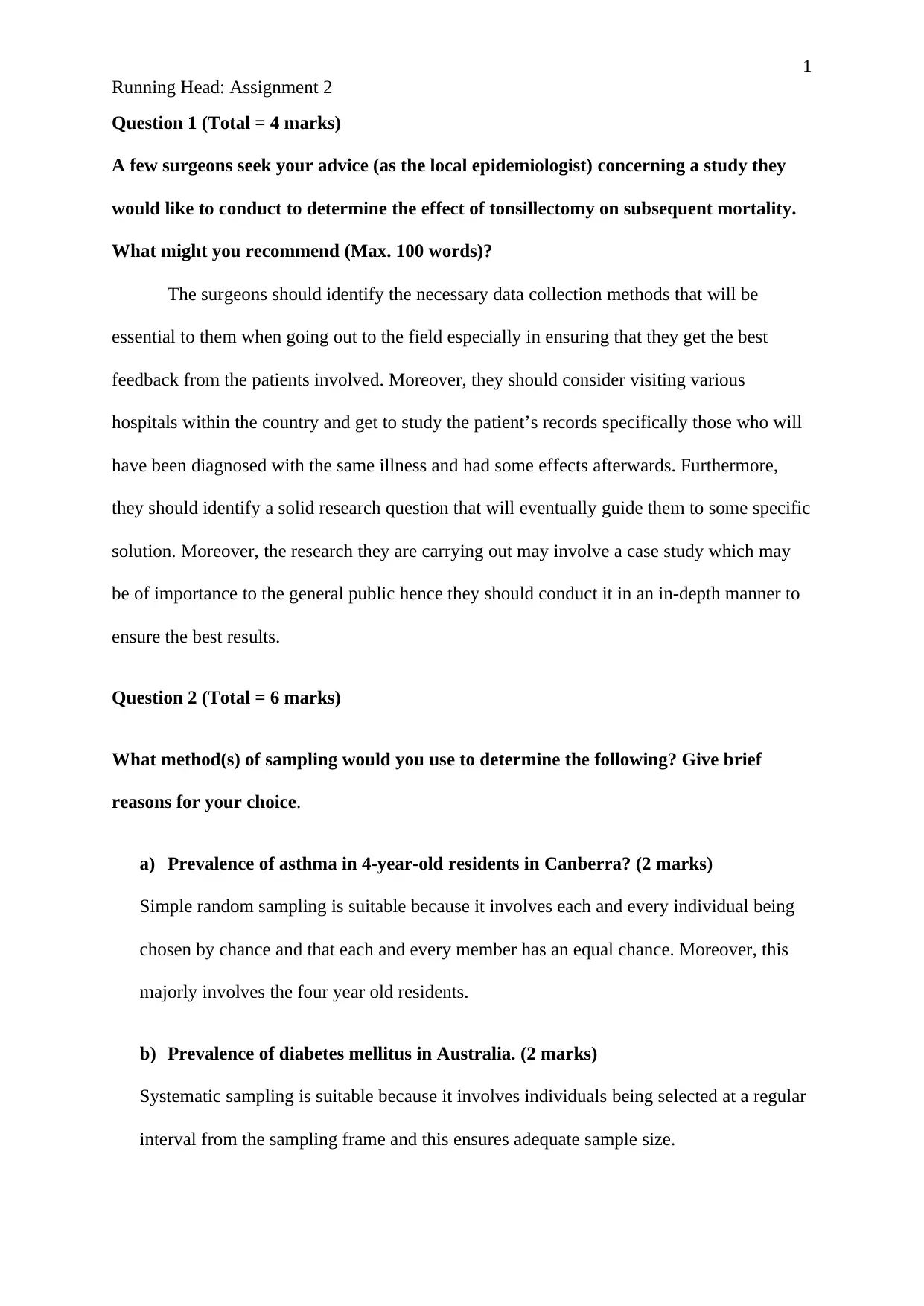
1
Running Head: Assignment 2
Question 1 (Total = 4 marks)
A few surgeons seek your advice (as the local epidemiologist) concerning a study they
would like to conduct to determine the effect of tonsillectomy on subsequent mortality.
What might you recommend (Max. 100 words)?
The surgeons should identify the necessary data collection methods that will be
essential to them when going out to the field especially in ensuring that they get the best
feedback from the patients involved. Moreover, they should consider visiting various
hospitals within the country and get to study the patient’s records specifically those who will
have been diagnosed with the same illness and had some effects afterwards. Furthermore,
they should identify a solid research question that will eventually guide them to some specific
solution. Moreover, the research they are carrying out may involve a case study which may
be of importance to the general public hence they should conduct it in an in-depth manner to
ensure the best results.
Question 2 (Total = 6 marks)
What method(s) of sampling would you use to determine the following? Give brief
reasons for your choice.
a) Prevalence of asthma in 4-year-old residents in Canberra? (2 marks)
Simple random sampling is suitable because it involves each and every individual being
chosen by chance and that each and every member has an equal chance. Moreover, this
majorly involves the four year old residents.
b) Prevalence of diabetes mellitus in Australia. (2 marks)
Systematic sampling is suitable because it involves individuals being selected at a regular
interval from the sampling frame and this ensures adequate sample size.
Running Head: Assignment 2
Question 1 (Total = 4 marks)
A few surgeons seek your advice (as the local epidemiologist) concerning a study they
would like to conduct to determine the effect of tonsillectomy on subsequent mortality.
What might you recommend (Max. 100 words)?
The surgeons should identify the necessary data collection methods that will be
essential to them when going out to the field especially in ensuring that they get the best
feedback from the patients involved. Moreover, they should consider visiting various
hospitals within the country and get to study the patient’s records specifically those who will
have been diagnosed with the same illness and had some effects afterwards. Furthermore,
they should identify a solid research question that will eventually guide them to some specific
solution. Moreover, the research they are carrying out may involve a case study which may
be of importance to the general public hence they should conduct it in an in-depth manner to
ensure the best results.
Question 2 (Total = 6 marks)
What method(s) of sampling would you use to determine the following? Give brief
reasons for your choice.
a) Prevalence of asthma in 4-year-old residents in Canberra? (2 marks)
Simple random sampling is suitable because it involves each and every individual being
chosen by chance and that each and every member has an equal chance. Moreover, this
majorly involves the four year old residents.
b) Prevalence of diabetes mellitus in Australia. (2 marks)
Systematic sampling is suitable because it involves individuals being selected at a regular
interval from the sampling frame and this ensures adequate sample size.
Paraphrase This Document
Need a fresh take? Get an instant paraphrase of this document with our AI Paraphraser
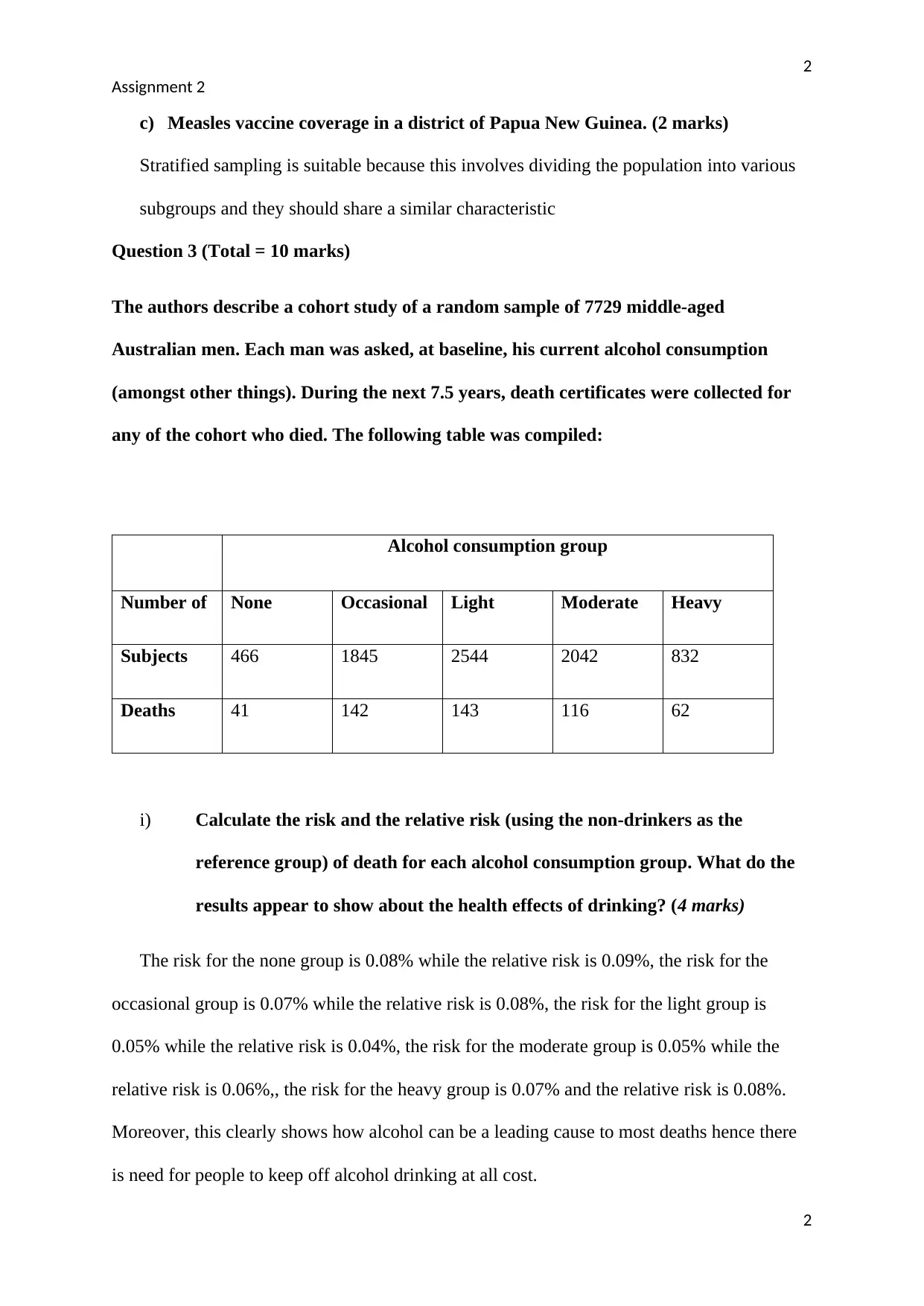
2
Assignment 2
c) Measles vaccine coverage in a district of Papua New Guinea. (2 marks)
Stratified sampling is suitable because this involves dividing the population into various
subgroups and they should share a similar characteristic
Question 3 (Total = 10 marks)
The authors describe a cohort study of a random sample of 7729 middle-aged
Australian men. Each man was asked, at baseline, his current alcohol consumption
(amongst other things). During the next 7.5 years, death certificates were collected for
any of the cohort who died. The following table was compiled:
Alcohol consumption group
Number of None Occasional Light Moderate Heavy
Subjects 466 1845 2544 2042 832
Deaths 41 142 143 116 62
i) Calculate the risk and the relative risk (using the non-drinkers as the
reference group) of death for each alcohol consumption group. What do the
results appear to show about the health effects of drinking? (4 marks)
The risk for the none group is 0.08% while the relative risk is 0.09%, the risk for the
occasional group is 0.07% while the relative risk is 0.08%, the risk for the light group is
0.05% while the relative risk is 0.04%, the risk for the moderate group is 0.05% while the
relative risk is 0.06%,, the risk for the heavy group is 0.07% and the relative risk is 0.08%.
Moreover, this clearly shows how alcohol can be a leading cause to most deaths hence there
is need for people to keep off alcohol drinking at all cost.
2
Assignment 2
c) Measles vaccine coverage in a district of Papua New Guinea. (2 marks)
Stratified sampling is suitable because this involves dividing the population into various
subgroups and they should share a similar characteristic
Question 3 (Total = 10 marks)
The authors describe a cohort study of a random sample of 7729 middle-aged
Australian men. Each man was asked, at baseline, his current alcohol consumption
(amongst other things). During the next 7.5 years, death certificates were collected for
any of the cohort who died. The following table was compiled:
Alcohol consumption group
Number of None Occasional Light Moderate Heavy
Subjects 466 1845 2544 2042 832
Deaths 41 142 143 116 62
i) Calculate the risk and the relative risk (using the non-drinkers as the
reference group) of death for each alcohol consumption group. What do the
results appear to show about the health effects of drinking? (4 marks)
The risk for the none group is 0.08% while the relative risk is 0.09%, the risk for the
occasional group is 0.07% while the relative risk is 0.08%, the risk for the light group is
0.05% while the relative risk is 0.04%, the risk for the moderate group is 0.05% while the
relative risk is 0.06%,, the risk for the heavy group is 0.07% and the relative risk is 0.08%.
Moreover, this clearly shows how alcohol can be a leading cause to most deaths hence there
is need for people to keep off alcohol drinking at all cost.
2
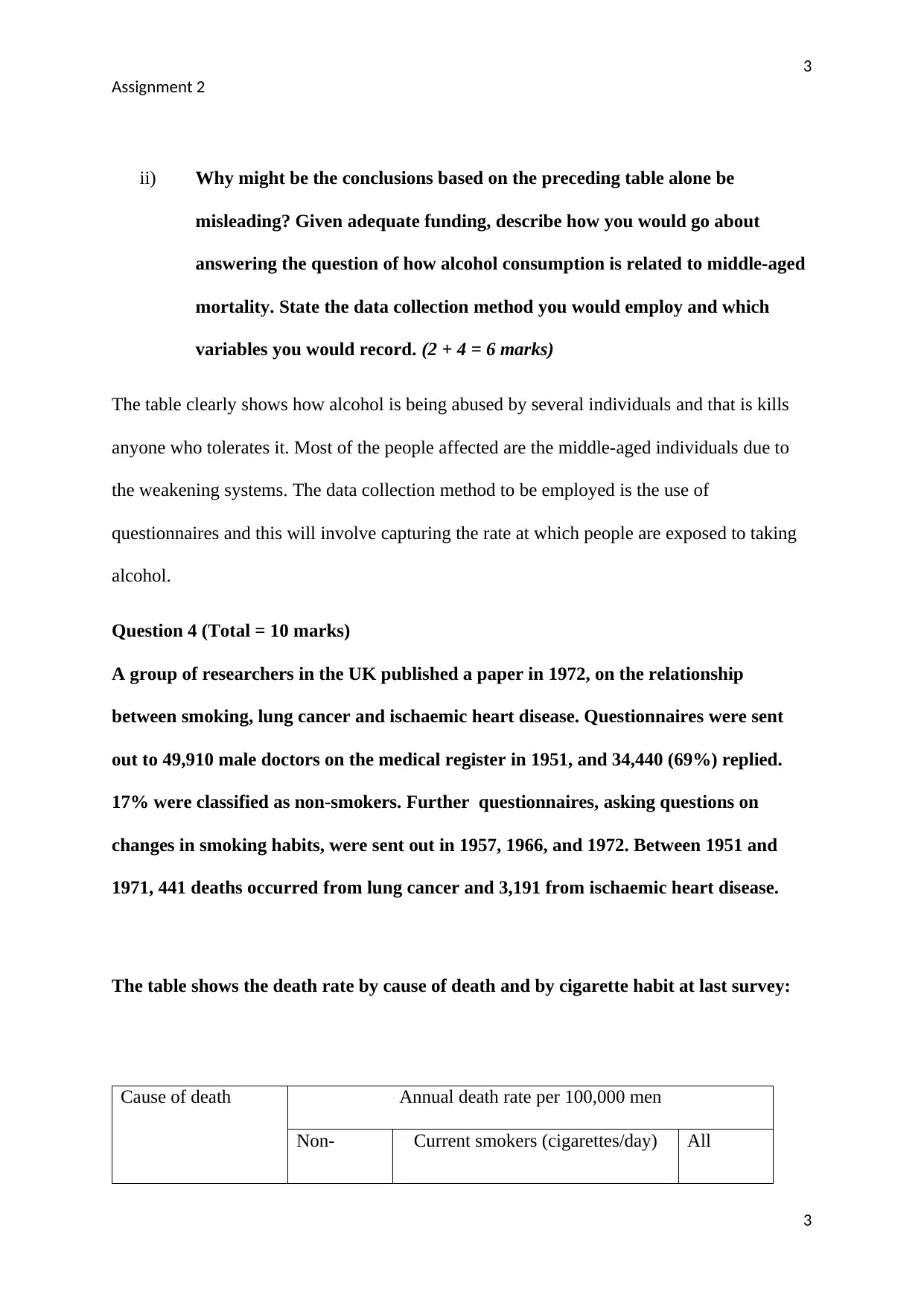
3
Assignment 2
ii) Why might be the conclusions based on the preceding table alone be
misleading? Given adequate funding, describe how you would go about
answering the question of how alcohol consumption is related to middle-aged
mortality. State the data collection method you would employ and which
variables you would record. (2 + 4 = 6 marks)
The table clearly shows how alcohol is being abused by several individuals and that is kills
anyone who tolerates it. Most of the people affected are the middle-aged individuals due to
the weakening systems. The data collection method to be employed is the use of
questionnaires and this will involve capturing the rate at which people are exposed to taking
alcohol.
Question 4 (Total = 10 marks)
A group of researchers in the UK published a paper in 1972, on the relationship
between smoking, lung cancer and ischaemic heart disease. Questionnaires were sent
out to 49,910 male doctors on the medical register in 1951, and 34,440 (69%) replied.
17% were classified as non-smokers. Further questionnaires, asking questions on
changes in smoking habits, were sent out in 1957, 1966, and 1972. Between 1951 and
1971, 441 deaths occurred from lung cancer and 3,191 from ischaemic heart disease.
The table shows the death rate by cause of death and by cigarette habit at last survey:
Cause of death Annual death rate per 100,000 men
Non- Current smokers (cigarettes/day) All
3
Assignment 2
ii) Why might be the conclusions based on the preceding table alone be
misleading? Given adequate funding, describe how you would go about
answering the question of how alcohol consumption is related to middle-aged
mortality. State the data collection method you would employ and which
variables you would record. (2 + 4 = 6 marks)
The table clearly shows how alcohol is being abused by several individuals and that is kills
anyone who tolerates it. Most of the people affected are the middle-aged individuals due to
the weakening systems. The data collection method to be employed is the use of
questionnaires and this will involve capturing the rate at which people are exposed to taking
alcohol.
Question 4 (Total = 10 marks)
A group of researchers in the UK published a paper in 1972, on the relationship
between smoking, lung cancer and ischaemic heart disease. Questionnaires were sent
out to 49,910 male doctors on the medical register in 1951, and 34,440 (69%) replied.
17% were classified as non-smokers. Further questionnaires, asking questions on
changes in smoking habits, were sent out in 1957, 1966, and 1972. Between 1951 and
1971, 441 deaths occurred from lung cancer and 3,191 from ischaemic heart disease.
The table shows the death rate by cause of death and by cigarette habit at last survey:
Cause of death Annual death rate per 100,000 men
Non- Current smokers (cigarettes/day) All
3
⊘ This is a preview!⊘
Do you want full access?
Subscribe today to unlock all pages.

Trusted by 1+ million students worldwide
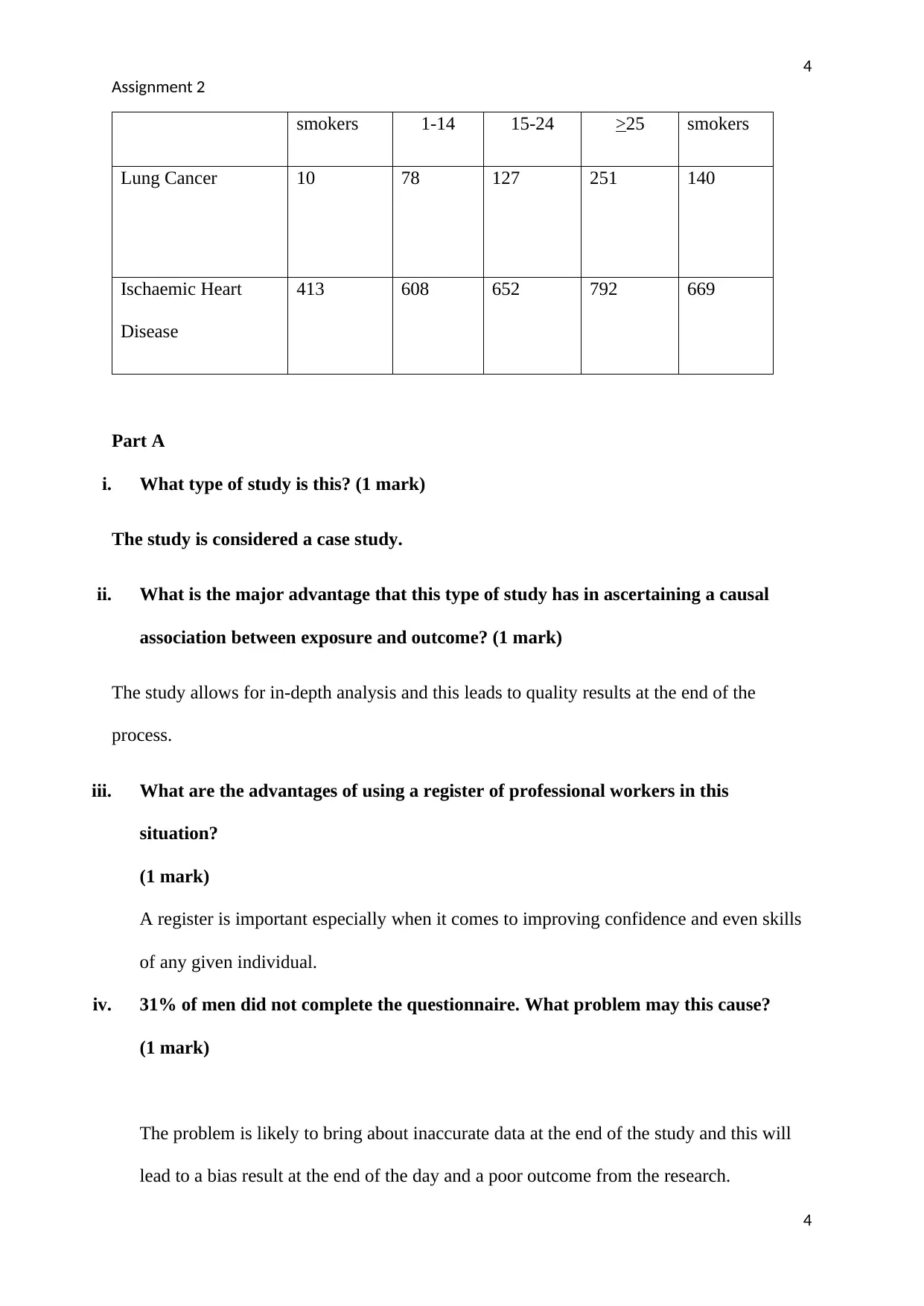
4
Assignment 2
smokers smokers1-14 15-24 >25
Lung Cancer 10 78 127 251 140
Ischaemic Heart
Disease
413 608 652 792 669
Part A
i. What type of study is this? (1 mark)
The study is considered a case study.
ii. What is the major advantage that this type of study has in ascertaining a causal
association between exposure and outcome? (1 mark)
The study allows for in-depth analysis and this leads to quality results at the end of the
process.
iii. What are the advantages of using a register of professional workers in this
situation?
(1 mark)
A register is important especially when it comes to improving confidence and even skills
of any given individual.
iv. 31% of men did not complete the questionnaire. What problem may this cause?
(1 mark)
The problem is likely to bring about inaccurate data at the end of the study and this will
lead to a bias result at the end of the day and a poor outcome from the research.
4
Assignment 2
smokers smokers1-14 15-24 >25
Lung Cancer 10 78 127 251 140
Ischaemic Heart
Disease
413 608 652 792 669
Part A
i. What type of study is this? (1 mark)
The study is considered a case study.
ii. What is the major advantage that this type of study has in ascertaining a causal
association between exposure and outcome? (1 mark)
The study allows for in-depth analysis and this leads to quality results at the end of the
process.
iii. What are the advantages of using a register of professional workers in this
situation?
(1 mark)
A register is important especially when it comes to improving confidence and even skills
of any given individual.
iv. 31% of men did not complete the questionnaire. What problem may this cause?
(1 mark)
The problem is likely to bring about inaccurate data at the end of the study and this will
lead to a bias result at the end of the day and a poor outcome from the research.
4
Paraphrase This Document
Need a fresh take? Get an instant paraphrase of this document with our AI Paraphraser
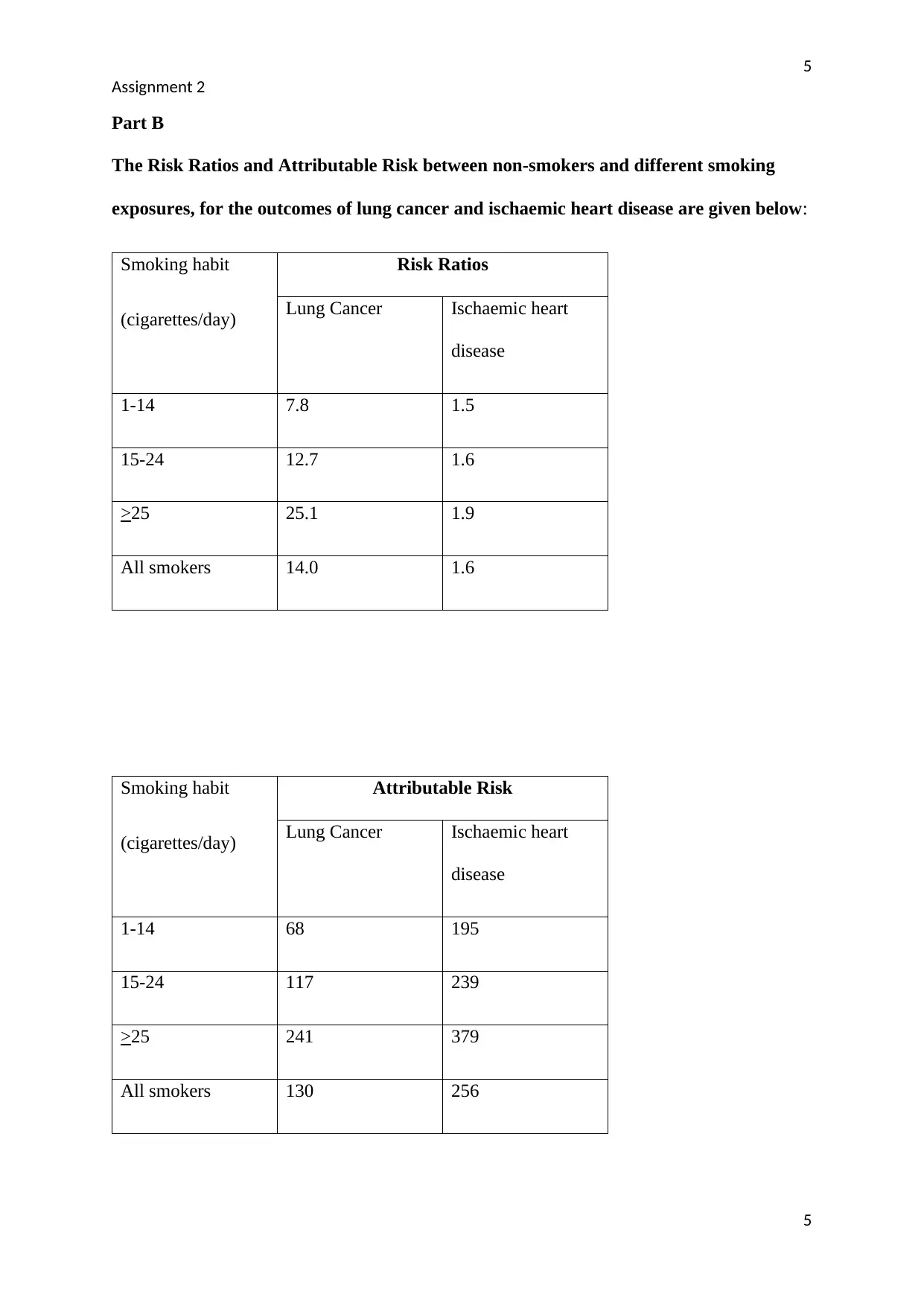
5
Assignment 2
Part B
The Risk Ratios and Attributable Risk between non-smokers and different smoking
exposures, for the outcomes of lung cancer and ischaemic heart disease are given below:
Smoking habit
(cigarettes/day)
Risk Ratios
Lung Cancer Ischaemic heart
disease
1-14 7.8 1.5
15-24 12.7 1.6
>25 25.1 1.9
All smokers 14.0 1.6
Smoking habit
(cigarettes/day)
Attributable Risk
Lung Cancer Ischaemic heart
disease
1-14 68 195
15-24 117 239
>25 241 379
All smokers 130 256
5
Assignment 2
Part B
The Risk Ratios and Attributable Risk between non-smokers and different smoking
exposures, for the outcomes of lung cancer and ischaemic heart disease are given below:
Smoking habit
(cigarettes/day)
Risk Ratios
Lung Cancer Ischaemic heart
disease
1-14 7.8 1.5
15-24 12.7 1.6
>25 25.1 1.9
All smokers 14.0 1.6
Smoking habit
(cigarettes/day)
Attributable Risk
Lung Cancer Ischaemic heart
disease
1-14 68 195
15-24 117 239
>25 241 379
All smokers 130 256
5
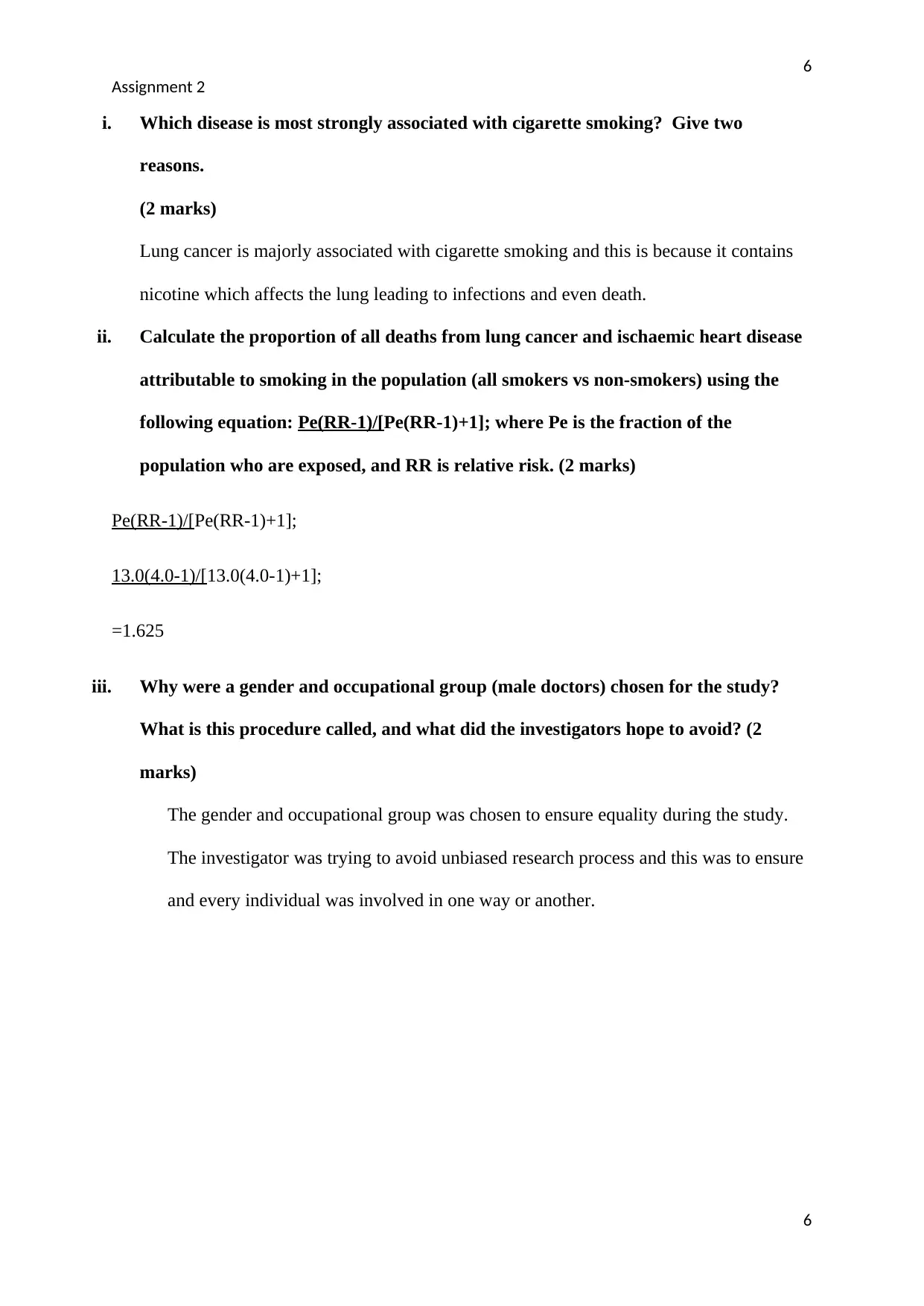
6
Assignment 2
i. Which disease is most strongly associated with cigarette smoking? Give two
reasons.
(2 marks)
Lung cancer is majorly associated with cigarette smoking and this is because it contains
nicotine which affects the lung leading to infections and even death.
ii. Calculate the proportion of all deaths from lung cancer and ischaemic heart disease
attributable to smoking in the population (all smokers vs non-smokers) using the
following equation: Pe(RR-1)/[Pe(RR-1)+1]; where Pe is the fraction of the
population who are exposed, and RR is relative risk. (2 marks)
Pe(RR-1)/[Pe(RR-1)+1];
13.0(4.0-1)/[13.0(4.0-1)+1];
=1.625
iii. Why were a gender and occupational group (male doctors) chosen for the study?
What is this procedure called, and what did the investigators hope to avoid? (2
marks)
The gender and occupational group was chosen to ensure equality during the study.
The investigator was trying to avoid unbiased research process and this was to ensure
and every individual was involved in one way or another.
6
Assignment 2
i. Which disease is most strongly associated with cigarette smoking? Give two
reasons.
(2 marks)
Lung cancer is majorly associated with cigarette smoking and this is because it contains
nicotine which affects the lung leading to infections and even death.
ii. Calculate the proportion of all deaths from lung cancer and ischaemic heart disease
attributable to smoking in the population (all smokers vs non-smokers) using the
following equation: Pe(RR-1)/[Pe(RR-1)+1]; where Pe is the fraction of the
population who are exposed, and RR is relative risk. (2 marks)
Pe(RR-1)/[Pe(RR-1)+1];
13.0(4.0-1)/[13.0(4.0-1)+1];
=1.625
iii. Why were a gender and occupational group (male doctors) chosen for the study?
What is this procedure called, and what did the investigators hope to avoid? (2
marks)
The gender and occupational group was chosen to ensure equality during the study.
The investigator was trying to avoid unbiased research process and this was to ensure
and every individual was involved in one way or another.
6
⊘ This is a preview!⊘
Do you want full access?
Subscribe today to unlock all pages.

Trusted by 1+ million students worldwide
1 out of 6
Your All-in-One AI-Powered Toolkit for Academic Success.
+13062052269
info@desklib.com
Available 24*7 on WhatsApp / Email
![[object Object]](/_next/static/media/star-bottom.7253800d.svg)
Unlock your academic potential
Copyright © 2020–2025 A2Z Services. All Rights Reserved. Developed and managed by ZUCOL.


